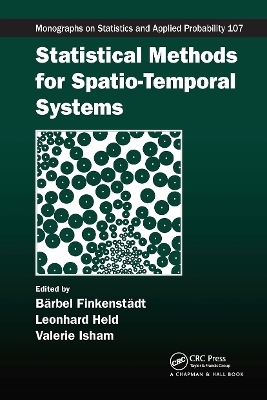
Statistical Methods for Spatio-Temporal Systems
Seiten
2006
Chapman & Hall/CRC (Verlag)
978-1-58488-593-1 (ISBN)
Chapman & Hall/CRC (Verlag)
978-1-58488-593-1 (ISBN)
Presents statistical research issues on spatio-temporal data modeling that promotes advances in research and an understanding between the mechanistic and the statistical modeling communities. This book offers a variety of statistical methods, including likelihood-based, nonparametric smoothing, Fourier, wavelet, and Markov chain Monte Carlo.
Statistical Methods for Spatio-Temporal Systems presents current statistical research issues on spatio-temporal data modeling and will promote advances in research and a greater understanding between the mechanistic and the statistical modeling communities.
Contributed by leading researchers in the field, each self-contained chapter starts with an introduction of the topic and progresses to recent research results. Presenting specific examples of epidemic data of bovine tuberculosis, gastroenteric disease, and the U.K. foot-and-mouth outbreak, the first chapter uses stochastic models, such as point process models, to provide the probabilistic backbone that facilitates statistical inference from data. The next chapter discusses the critical issue of modeling random growth objects in diverse biological systems, such as bacteria colonies, tumors, and plant populations. The subsequent chapter examines data transformation tools using examples from ecology and air quality data, followed by a chapter on space-time covariance functions. The contributors then describe stochastic and statistical models that are used to generate simulated rainfall sequences for hydrological use, such as flood risk assessment. The final chapter explores Gaussian Markov random field specifications and Bayesian computational inference via Gibbs sampling and Markov chain Monte Carlo, illustrating the methods with a variety of data examples, such as temperature surfaces, dioxin concentrations, ozone concentrations, and a well-established deterministic dynamical weather model.
Statistical Methods for Spatio-Temporal Systems presents current statistical research issues on spatio-temporal data modeling and will promote advances in research and a greater understanding between the mechanistic and the statistical modeling communities.
Contributed by leading researchers in the field, each self-contained chapter starts with an introduction of the topic and progresses to recent research results. Presenting specific examples of epidemic data of bovine tuberculosis, gastroenteric disease, and the U.K. foot-and-mouth outbreak, the first chapter uses stochastic models, such as point process models, to provide the probabilistic backbone that facilitates statistical inference from data. The next chapter discusses the critical issue of modeling random growth objects in diverse biological systems, such as bacteria colonies, tumors, and plant populations. The subsequent chapter examines data transformation tools using examples from ecology and air quality data, followed by a chapter on space-time covariance functions. The contributors then describe stochastic and statistical models that are used to generate simulated rainfall sequences for hydrological use, such as flood risk assessment. The final chapter explores Gaussian Markov random field specifications and Bayesian computational inference via Gibbs sampling and Markov chain Monte Carlo, illustrating the methods with a variety of data examples, such as temperature surfaces, dioxin concentrations, ozone concentrations, and a well-established deterministic dynamical weather model.
Bärbel Finkenstädt, Leonhard Held, Valerie Isham
Preface. Spatio-Temporal Point Processes: Methods and Applications. Spatio-Temporal Modeling-With a View to Biological Growth. Using Transforms to Analyze Space-Time Processes. Geostatistical Space-Time Models, Stationarity, Separability, and Full Symmetry. Space-Time Modeling of Rainfall for Continuous Simulation. A Primer on Space-Time Modeling from a Bayesian Perspective. Index.
| Erscheint lt. Verlag | 20.10.2006 |
|---|---|
| Sprache | englisch |
| Maße | 156 x 234 mm |
| Gewicht | 566 g |
| Themenwelt | Mathematik / Informatik ► Mathematik ► Statistik |
| ISBN-10 | 1-58488-593-9 / 1584885939 |
| ISBN-13 | 978-1-58488-593-1 / 9781584885931 |
| Zustand | Neuware |
| Haben Sie eine Frage zum Produkt? |
Mehr entdecken
aus dem Bereich
aus dem Bereich
Eine Einführung für Wirtschafts- und Sozialwissenschaftler
Buch | Softcover (2022)
De Gruyter Oldenbourg (Verlag)
CHF 41,90


